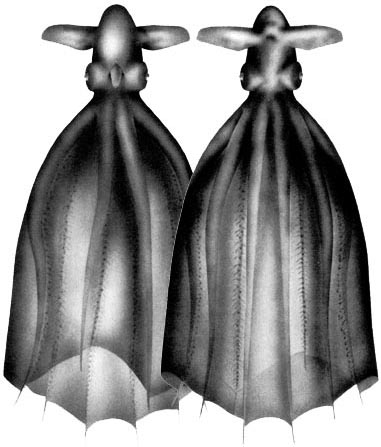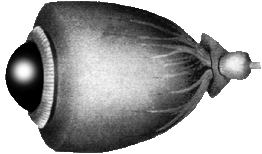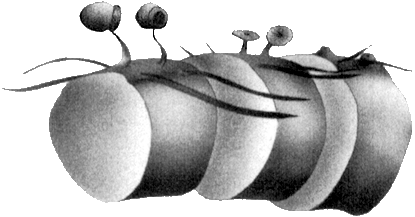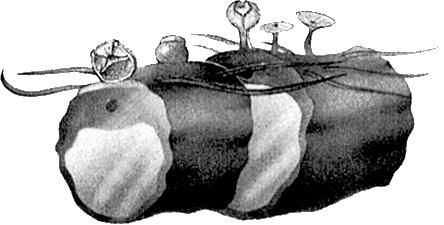Cirrothauma magna
Michael Vecchione and Richard E. YoungIntroduction
C. magna is a large (up to 1200 mm TL) but fragile deep-sea cirrate that is known from 4 specimens captured from the Atlantic, Pacific and Indian Oceans.
Brief diagnosis:
A Cirrothauma ...
- with normal eyes bearing lenses.
Characteristics
- Head
- Eyes: Functional eyes (eyes with lenses).
- Beaks: Descriptions can be found here: Lower beak; upper beak.
Figure. Eye of C. magna, male, 220 mm ML. At the far right of the drawing is the optic stalk that enters the optic lobe of the brain. From this the optic nerves pass through the white body and into the eyeball. Drawing from Guerra, et al., 1998.
- Suckers
- Arms with 3 types of suckers (top figure; bottom figure shows the two more distal types).
- Suckers nearest mouth: small, cyclindrical, closely spaced, with stout stalk.
- Following suckers: larger and on long stalks; thin, broad, infundibulum with small openings (acetabulum, apparently, nearly absent); infundibulum can inflate or deflate to form a spherical (see middle sucker in bottom drawing), flattened or "half-closed eyelid."
- Suckers of distal third of arm: large, fleshy with bowl-like, amphora-like or barrel-like shape; sessile with rigid, muscular base (however see top figure where these suckers have long stalks).
Figure. Top - Three sections of the arm, submature female of C. magna, 140 mm ML. Bottom - Two sections of the arm, mature male, 220 mm ML. Drawings from Guerra, et al., 1998.
- Web
- Distal web attachments to each arm asymmetrical.
- Web nodules absent.
Comments
The above description is taken from Guerra et al., 1998. Additional features of the description can be found here.
Nomenclature
C. magna was traditionally placed in Cirroteuthis although Robson (1932) and Nesis (1987) questioned this placement. O'Shea (1999) noted the similarity of the shell to that of Cirrothauma and moved the species to that genus.
Hoyle (1886) described a second but mutilated specimen along with his redescription of the holotype. Robson (1932) suggested that this second specimen belonged to a separate species which he named Cirroteuthis hoylei. The status of this latter species is uncertain.
Distribution
Type locality: 46°46'S, 45°31'E, south Indian Ocean between Prince Edward Island and the Crozets, 2557 m.The specimens described by Guerra, et al. (1998) were taken at 15°29'N, 46°34'W in the central North Atlantic (male) and 23°00'N, 17°34'W in the North Alantic off West Africa (female).
O'Shea (1999) suspects that a specimen taken off New Zealand at 39°58'S, 178°02'E, 1450-1468 m, represents a new species.
References
Guerra, R., R. Villanueva, K. N. Nesis and J. Bedoya. 1998. Redescription of the deep-sea cirrate octopod Cirroteuthis magna Hoyle, 1885, and considerations on the genus Cirroteuthis (Mollusca: Cephalopoda). Bull. Mar. Sci., 63: 51-81.
Hoyle, W. E. 1886. Report on the Cephalopoda. Rept. Sci. Res. Challenger. 16 (44): 246 pp.
O’Shea, Steve. 1999. The Marine Fauna of New Zealand: Octopoda (Mollusca: Cephalopoda). NIWA Biodiversity Memoir 112: 280pp.
Voss, G. L. and W. G. Pearcy. 1990. Deep-water octopods (Mollusca: Cephalopoda) of the Northeastern Pacific. Proc. Calif. Acad. Sci. 47: 47-94.
Title Illustrations

| Scientific Name | Cirrothauma magna |
|---|---|
| Reference | Guerra, R., R. Villanueva, K. N. Nesis and J. Bedoya. 1998. Redescription of the deep-sea cirrate octopod Cirroteuthis magna Hoyle, 1885, and considerations on the genus Cirroteuthis (Mollusca: Cephalopoda). Bull. Mar. Sci., 63: 51-81. |
| Acknowledgements | Printed with permission from the Bulletin of Marine Science. |
| Sex | Male |
| Life Cycle Stage | Mature |
| View | Ventral (top) and dorsal (bottom) |
| Size | 220 mm ML |
| Copyright | © 1998 Bulletin of Marine Science |
About This Page

National Museum of Natural History, Washington, D. C. , USA

University of Hawaii, Honolulu, HI, USA
Page copyright © 2016 and
 Page: Tree of Life
Cirrothauma magna .
Authored by
Michael Vecchione and Richard E. Young.
The TEXT of this page is licensed under the
Creative Commons Attribution-NonCommercial License - Version 3.0. Note that images and other media
featured on this page are each governed by their own license, and they may or may not be available
for reuse. Click on an image or a media link to access the media data window, which provides the
relevant licensing information. For the general terms and conditions of ToL material reuse and
redistribution, please see the Tree of Life Copyright
Policies.
Page: Tree of Life
Cirrothauma magna .
Authored by
Michael Vecchione and Richard E. Young.
The TEXT of this page is licensed under the
Creative Commons Attribution-NonCommercial License - Version 3.0. Note that images and other media
featured on this page are each governed by their own license, and they may or may not be available
for reuse. Click on an image or a media link to access the media data window, which provides the
relevant licensing information. For the general terms and conditions of ToL material reuse and
redistribution, please see the Tree of Life Copyright
Policies.
- First online 13 May 2003
- Content changed 27 February 2016
Citing this page:
Vecchione, Michael and Richard E. Young. 2016. Cirrothauma magna . Version 27 February 2016 (under construction). http://tolweb.org/Cirrothauma_magna/20098/2016.02.27 in The Tree of Life Web Project, http://tolweb.org/











 Go to quick links
Go to quick search
Go to navigation for this section of the ToL site
Go to detailed links for the ToL site
Go to quick links
Go to quick search
Go to navigation for this section of the ToL site
Go to detailed links for the ToL site